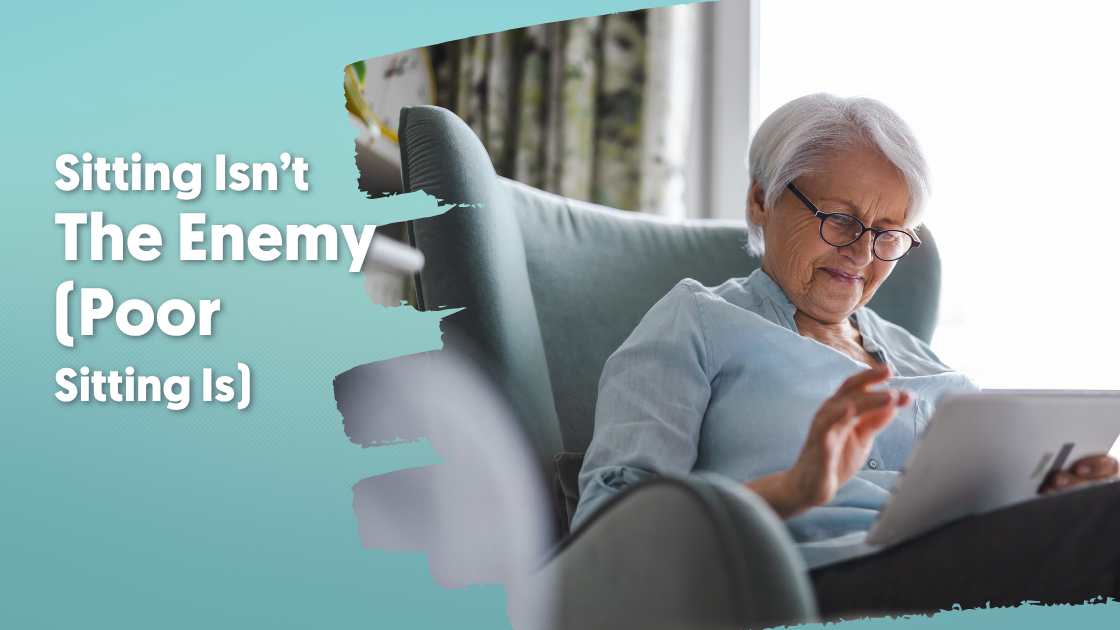You’ve probably heard the phrase “sitting is the new smoking.” It may sound a bit dramatic, but it’s easy to start believing that sitting down- even for a moment- is bad for you. While sitting for hours on end isn’t ideal, the real problem isn’t the fact that you’re sitting. What really causes those aches and pains in your neck, shoulders, and lower back is poor sitting posture and staying in one position too long.

The truth is, your body is designed to move. When you sit for long hours without shifting, your muscles stiffen, joints start to compress, and your circulation slows down. Now, this doesn’t mean that sitting is inherently bad or that you need to stand all day, it just means you need to learn how to sit smarter.
Why Sitting Can Cause Pain
Think about your normal sitting habits. Do you lean forward toward your computer screen? What about slumping back in your chair after a couple of hours? Maybe you cross your legs when you’re reading the paper or tuck one leg under the other. These small, seemingly harmless positions can add up over time.
When you sit in awkward or unsupported positions, your body has to work harder to stay balanced. If you’re hunching forward to see your screen, the muscles in your neck and upper back become strained, which can cause tension headaches and shoulder pain. Slouching into your chair weakens your core and rounds your spine, making your lower back more vulnerable. Even something as simple as crossing your legs can throw your hips and knees out of alignment.
It’s not the act of sitting that’s dangerous, it’s static sitting, or staying in one position without moving. Your muscles and joints are literally craving motion. So, the longer you’re sitting still, the more they’ll start to complain.
Setting Up Your Space The Right Way
You don’t need expensive equipment to make your workspace more comfortable, just a few small tweaks can make a big difference in how your body feels at the end of the day. First, start with your chair height. Ideally, your feet should always be resting flat on the ground, and your knees and hips should be at about a 90° angle. If your chair doesn’t go low enough, try using a footrest or small box for support.
Next, focus on your lower back. Most chairs don’t have enough lumbar support, but that’s an easy fix. Roll up a towel or grab a lumbar pillow if you have one and place it behind you, just above the small of your back. This helps your spine keep its natural curve and also prevents you from slouching.
Your screen height matters, too. If it’s too low, you’ll find yourself looking down all day and straining your neck. Instead, try positioning your monitor so it’s slightly above your eye line. You can raise it up with a monitor riser or even stack some books underneath.
Lastly, keep your essentials close enough so you don’t have to constantly reach or twist. That means your keyboard, mouse, notepad, whatever. Your wrists should stay in a neutral position, not bent, and your elbows should relax comfortably by your sides. Depending on your setup, you may want to invest in a keyboard tray to help get the positioning just right.
One last thing: if you use a laptop, it’s a good idea to get a separate mouse and keyboard so you can get your screen to a good height. Small changes like these really go a long way toward reducing strain and improving your posture.
Sitting Smart At Home
When you’re at home, posture tends to take a back seat. It’s easy to curl up on the couch, lean on the kitchen counter while you work, or lounge in bed with a tablet. While these positions can be comfortable at first, they can quickly make you stiff and sore.
Couches generally don’t provide a lot of back support. So when you’re sitting, it helps to put a small rolled up towel or pillow behind your back. If you’re watching tv or scrolling on your phone, make sure your screen is at your eye level or a little bit above. Even if that means mounting your tv higher, the goal is to avoid looking down and bending your neck forward. If you read or use a laptop when you’re on the couch, consider setting them on a tv tray or stacking fluffy pillows to bring them closer to eye level.
Don’t forget about the “TV stretch rule” either. Every time there’s a commercial break (or every 30 minutes if you’re streaming without commercials) stand up and stretch. Just by taking a short walk to refill your water or stretching your arms overhead can get your blood moving and wake up tired muscles.
The 30 Minute Rule
Even with the perfect setup, your body still needs movement. That’s just how it is. A good rule of thumb is to change your position or stand up every 30 to 40 minutes, like with the TV stretch rule. You don’t need to do anything complicated- simply taking a moment to stretch or walk into another room helps.
These mini breaks reset your posture, improve blood flow, and give your brain a quick (and much needed) recharge. You might also find that you’re more focused and less fatigued throughout your day just by adding these small movement breaks.
Posture Is Dynamic, Not Perfect
Most people think that their posture is something they need to “hold” all day long. Well, here’s the secret every physical therapist wants you to know: there’s no such thing as perfect posture. Chest up, shoulders back, chin tucked- these are all things that aren’t meant to be stiff or forced. Posture is actually supposed to be dynamic, meaning it changes as you move, bend, sit, and reach.
The best posture you can have is your next posture. In other words, the one you’re going to switch to. So, instead of trying to hold a single “perfect” position all day (which can cause tension,) aim for a variety of postures. Switch things up, change positions often, stand for phone calls, perch on the edge of your chair for a bit. Listen to your body’s cues to move- if you feel the urge to shift, do it.
The Takeaway
Sitting isn’t the enemy, poor sitting habits are. So don’t be afraid to sit, just sit smarter. The key to feeling your best is movement, support, and awareness. A few simple changes to your setup and daily routine can help in a big way so you sit comfortably, reduce pain, and protect your body for the long haul.
Just remember, your posture doesn’t have to be perfect, it just has to be active. Move often, adjust the space around you, and give your body some variety (it deserves it!)
If you find yourself dealing with neck, back, or hip pain from sitting, our team can help. We’ll assess your posture, review your workspace and house setup, and teach you simple strategies to get your body feeling its best. Schedule a posture and ergonomic assessment today and start sitting smarter!
Click here to learn more about preventing pain while working at your desk.



